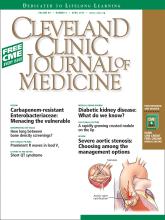Table of Contents
From the Editor
- Resistance of man and bug
Why individual clinicians make specific decisions usually can be sorted out. But our behavior as a group is more difficult to understand—and to alter.
The Clinical Picture
- Implications of a prominent R wave in V1
A 19-year-old woman presents with exertional dyspnea. What can her electrocardiogram tell us?
- A rapidly growing crusted nodule on the lip
The patient, who had a squamous cell carcinoma, underwent Mohs surgery and has done well.
Medical Grand Rounds
- Detecting and controlling diabetic nephropathy: What do we know?
Diabetic kidney disease is on the rise. Strategies to prevent or control it are lowering blood pressure, controlling blood sugar, and inhibiting the renin-angiotensin-aldosterone system.
Review
- Carbapenem-resistant Enterobacteriaceae: A menace to our most vulnerable patients
The emergence of carbapenem-resistant Enterobacteriaceae (CRE) highlights the importance of effective antibiotics to maintain the safety of our health care system. Clinicians will encounter CRE as a cause of difficult-to-treat and often fatal infections in hospitalized patients. We review the mechanisms of carbapenem resistance, the dissemination and clinical impact of these resistant organisms, and challenges to their detection, treatment, and control.
- Options for managing severe aortic stenosis: A case-based review
Today, patients who cannot undergo surgery can be offered a variety of less invasive treatments. We use seven cases to illustrate how to manage these patients.
Interpreting Key Trials
- Bone mineral density testing: Is a T score enough to determine the screening interval?
Although a trial found that women with normal or only slightly low results need not come back for another 15 years, it may not be so simple.
Editorial
- What should be the interval between bone density screenings?
Doctors should not order unnecessary and expensive tests and should not recommend frequent repeated testing that does not benefit the patient.
- Aortic valve replacement: Options, improvements, and costs
How aortic valve disease is managed continues to evolve. Issues include outcomes and costs.




